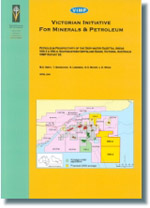VIMP Report 65 - Petroleum prospectivity of the deep-water gazettal areas V00-3 & V00-4, southeastern Gippsland Basin, Victoria
 |
| |||||
Product description:Download The downloadable version of this report is supplied in PDF format. Executive Summary The offshore Gippsland Basin is Australia's premier petroleum province with reserves initially exceeding four billion barrels of crude oil and condensate and 10 TCF of natural gas. Its production meets around 40% of Australia's crude oil needs and most of Victoria's gas requirements. It is located approximately 200 km from Melbourne and is well serviced by roads and population centres. A network of pipelines brings produced hydrocarbons onshore to petroleum processing facilities located at Longford. Recent gazettal rounds in the Gippsland Basin have resulted in a number of new acreage awards outside the Esso/BHPP joint venture production licences. The increased interest is being expressed from various companies, spanning both large and small oil industry players and may be attributed to a number of factors ranging from improvements in technology to the changing economic and regulatory environment. The main factors that are changing business attitude towards this prolific basin are:
Area V00-3 contains two abandoned wells, drilled in 1992 and 1996. These wells penetrated only the uppermost section of the Latrobe Siliciclastics. Whale Shark-1 is interpreted as a probable invalid trap test, drilled on the flank of a closure while failure in Great White-1 is interpreted to be related to an absence of migration pathways into the trap. The most important and relevant wells are immediately outside the permit area and greatly contribute to the understanding of the hydrocarbon potential of the block. These wells include the field discovery wellsSole-1, Basker-1, Manta-1, Blackback-1 and Terakihi-1. Eight structural trapping trends are delineated in the gazettal blocks. They are associated with a range of play types including major channel incision plays, uplifted anticlinal and collapsed structures that contain sequences of marine sandstones and shales (a deepwater analogue of the Marlin and Turrum fields) as well as large marine shale-draped basement horsts. A seismic sequence stratigraphic study has delineated an extensive coastal plain facies assemblage in the Golden Beach Subgroup, extending the limits of source rock distribution well beyond that of previous assessments. Interpreted structural dips over large areas of the source kitchen interval are generally to the west and north. This provides migration pathways from proven sources, and from the newly delineated source intervals in the Golden Beach Subgroup, to extensive segments of the gazettal areas. In summary, the gazettal of areas V00-3 and V00-4 provides potentially outstanding investment opportunities giving first access to the remaining large undrilled structures of the Gippsland Basin. Opportunities exist to explore and develop potentially large oil and gas accumulations in close proximity to infrastructure. Moreover, any successful discovery would be optimally positioned to participate in the supply of gas to the growing southeastern Australian market. Bibliographic reference Smith, M.A., Bernecker, T., Liberman, N., Moore, D.H. & Wong, D., 2000. Petroleum prospectivity of the deep-water gazettal areas V00-3 & V00-4, southeastern Gippsland Basin, Victoria. Victorian Initiative for Minerals and Petroleum Report 65. Department of Natural Resources and Environment. | ||||||

